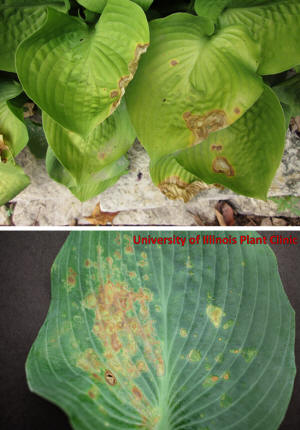|
 Column Column
Bagworms and Leaf Spots on Hostas
By John Fulton
 Send a link to a friend
Send a link to a friend
[June 04, 2016]
Bagworms - Bagworms are an
insect that conjures up images for many people. There are bagworms,
and there are other larvae that live in a bag for at least part of
their life cycle. We have bagworms, Eastern Tent Caterpillar, and
Fall Webworms. For the true “bagworm,” the insect that constructs a
small bag like an ice cream cone from the leaf material of the tree
or shrub it is on, the year-in and year-out treatment time for
bagworms is June 15. You can mark this date on your calendar for
next year and be within a few days of the correct treatment time.
The cool spring followed by a very warm stretch probably mean the
temperatures will really even out. There are a few small bagworms
already out, but the idea is to have all the eggs hatched before
treatment.
|
|
 The next problem is what to use. The traditional standby has
been Sevin, but the B.t. products such as Dipel and Thuricide
have really taken the majority of the market. Many other
products will work, but the B.t. products have several good
points including safety to mammals and toxicity to larger
bagworms. Since they are bacteria that affect only the larvae of
moths and butterflies, it does take a while for the bacteria to
build up to the point where they can kill the bagworm. I won’t
get into the discussion about Monarch butterflies lighting in
the tree just after treatment. And an item to note: there are
several different strains of B.t. now on the market. One is for
control of mosquito larvae, so make sure you get the correct one
by reading on the label what insects will be controlled. The next problem is what to use. The traditional standby has
been Sevin, but the B.t. products such as Dipel and Thuricide
have really taken the majority of the market. Many other
products will work, but the B.t. products have several good
points including safety to mammals and toxicity to larger
bagworms. Since they are bacteria that affect only the larvae of
moths and butterflies, it does take a while for the bacteria to
build up to the point where they can kill the bagworm. I won’t
get into the discussion about Monarch butterflies lighting in
the tree just after treatment. And an item to note: there are
several different strains of B.t. now on the market. One is for
control of mosquito larvae, so make sure you get the correct one
by reading on the label what insects will be controlled.

If you are in doubt about whether you have bagworms, check your
trees and shrubs around June 15. Many times, bagworms are
concentrated in the tops of trees, so thorough coverage is
important. You can actually see the small bags as the larvae
build them. They become very noticeable at about 1/16 of an inch
long. Treat bagworms early, since larger ones are more difficult
to control, but try to ensure the eggs are all hatched out –
hence the June 15 date.
Most people think that bagworms only affect evergreens.
Evergreens seem to be their preferred host group, but bagworms
have a huge number of potential hosts. Through the years I have
seen them on oak trees, grape vines, apples, and about any other
growing thing you can think of.
Leaf Spots on Hosta
The Plant Clinic is reporting seeing several hosta samples with
leaf spots caused by various fungi. Anthracnose is one of the
main culprits. It is related to, but different, than the
anthracnose which affects sycamore and other trees. It is
favored by the type of weather we have been experiencing.
Irregular dead spots form, and these can tatter out with rains
and wind to look like something has been eating on the leaves,
however this isn’t the case with anthracnose. There are actually
several fungi which cause similar problems, including Botrytis,
Fusarium, and Alternaria.
[to top of second column] |


The best offense is a good defense. This means don’t create
conditions favorable to the development of the disease. Allow for
good air circulation by spacing plants adequately, water in the
morning to allow for drying during the day, and try to water the
soil rather than the foliage. Use of fungicides can protect good
leaves, but won’t cure infections already present. Products with
copper, sulfur, and many of the commercial fungicides are effective
in controlling new infections when applied every 10 to 14 days.
[By JOHN FULTON, COUNTY EXTENSION
DIRECTOR SERVING LOGAN, MENARD, AND SANGAMON COUNTIES]
 |